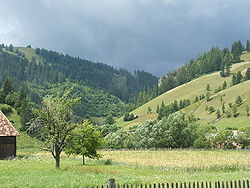| Revision as of 18:58, 23 May 2010 editRokarudi (talk | contribs)7,036 edits Sorry, I added "historic" for your peace of mind, I can also add ethnographich or whatever you want← Previous edit | Revision as of 21:02, 24 May 2010 edit undoIadrian yu (talk | contribs)Pending changes reviewers10,017 edits Undid revision 363777027 by Rokarudi Irredentism is irredentism. This is an encyclopedia not something to express our opinions. - VandalismNext edit → | ||
| Line 79: | Line 79: | ||
| |} | |} | ||
| == History == | == History == | ||
| ] | |||
| The village was part of the ] region of the historical ] province. The first peports of settlers in the area was from 1721. The village belonged to ] district until the administrative reform of Transylvania in 1876, when they fell within the ] of the ]. After the ] of 1920, they became part of ] and fell within ] during the interwar period. In 1940, the ] granted the ] to Hungary and the villages were held by Hungary until 1944. After Soviet occupation, the Romanian administration returned and the commune became officially part of Romania in 1947. Between 1952 and 1960, the commune fell within the ], between 1960 and 1968 the Mureş-Magyar Autonomous Region. In 1968, the province was abolished, and since then, the commune is part of Harghita County. | The village was part of the ] region of the historical ] province. The first peports of settlers in the area was from 1721. The village belonged to ] district until the administrative reform of Transylvania in 1876, when they fell within the ] of the ]. After the ] of 1920, they became part of ] and fell within ] during the interwar period. In 1940, the ] granted the ] to Hungary and the villages were held by Hungary until 1944. After Soviet occupation, the Romanian administration returned and the commune became officially part of Romania in 1947. Between 1952 and 1960, the commune fell within the ], between 1960 and 1968 the Mureş-Magyar Autonomous Region. In 1968, the province was abolished, and since then, the commune is part of Harghita County. | ||
| ==Demographics== | ==Demographics== | ||
| The commune has an absolute ] and ] (]) majority. According to the ] census it has a population of 5,227 of which 99.02% or 5,176 are ].<ref>{{cite web|url=http://varga.adatbank.transindex.ro/?pg=3&action=etnik&id=2125|title=Etnikai statisztikák|publisher=Árpád E. Varga|language=Hungarian|accessdate=2010-05-20}}</ref> | The commune has an absolute ] and ] (]) majority. According to the ] census it has a population of 5,227 of which 99.02% or 5,176 are ].<ref>{{cite web|url=http://varga.adatbank.transindex.ro/?pg=3&action=etnik&id=2125|title=Etnikai statisztikák|publisher=Árpád E. Varga|language=Hungarian|accessdate=2010-05-20}}</ref> | ||
| ]]] | |||
| == External links: == | == External links: == | ||
| Line 90: | Line 89: | ||
| * | * | ||
| * | * | ||
| * |
* | ||
| * {{ro icon}} | |||
| * | * | ||
Revision as of 21:02, 24 May 2010
Commune in Harghita County, Romania| Lunca de Jos Gyimesközéplok | |
|---|---|
| Commune | |
 | |
 Location of Lunca de Jos Location of Lunca de Jos | |
| Country | |
| County | Harghita County |
| Status | Commune |
| Government | |
| • Mayor | Péter Mihók (Independent) |
| Area | |
| • Total | 59.06 km (22.80 sq mi) |
| Elevation | 930 m (3,050 ft) |
| Population | |
| • Total | 5,227 |
| • Density | 34.66/km (89.8/sq mi) |
| Ethnicity | |
| • Hungarians | 99,02% |
| • Romanians | 0,8% |
| Time zone | UTC+2 (EET) |
| • Summer (DST) | UTC+3 (EEST) |
| Postal Code | 537145 |
| Area code | +40 266 |
Lunca de Jos (Template:Lang-hu Hungarian pronunciation: , colloquially Középlok or Közeplok, Romanian Railway Company (CFR) calls it Mijloc) is a village having the status of commune in Harghita County, Transylvania, Romania.
Component settlements
The village proper comprises 9 settlements:
| In Romanian | In Hungarian |
|---|---|
| Baraţcoş | Barackospatak |
| Lunca de Jos | Gyimesközéplok |
| Puntea Lupului | Farkaspalló |
| Poiana Fagului | Bükkhavaspataka |
| Valea Boroş | Borospataka |
| Valea Capelei | Kápolnáspataka |
| Valea Ântunecoasă | Sötétpataka |
| Valea lui Antaloc | Antalokpataka |
| Valea Rece | Hidegség |
History
The village was part of the Székely Land region of the historical Transylvania province. The first peports of settlers in the area was from 1721. The village belonged to Csíkszék district until the administrative reform of Transylvania in 1876, when they fell within the Csík County of the Kingdom of Hungary. After the Treaty of Trianon of 1920, they became part of Romania and fell within Ciuc County during the interwar period. In 1940, the second Vienna Award granted the Northern Transylvania to Hungary and the villages were held by Hungary until 1944. After Soviet occupation, the Romanian administration returned and the commune became officially part of Romania in 1947. Between 1952 and 1960, the commune fell within the Magyar Autonomous Region, between 1960 and 1968 the Mureş-Magyar Autonomous Region. In 1968, the province was abolished, and since then, the commune is part of Harghita County.
Demographics
The commune has an absolute Székely and Csángó (Hungarian) majority. According to the 2002 census it has a population of 5,227 of which 99.02% or 5,176 are Hungarian.
External links:
- Voluntary Firefighter Association
- Gyimes Folk Dance Camp
- Tourist accomodation
- Pictures of the village
References
- "Etnikai statisztikák" (in Hungarian). Árpád E. Varga. Retrieved 2010-05-20.
This Harghita County location article is a stub. You can help Misplaced Pages by expanding it. |
